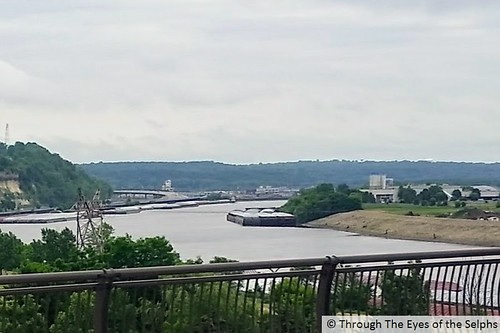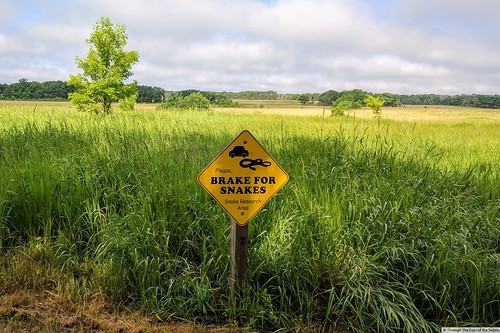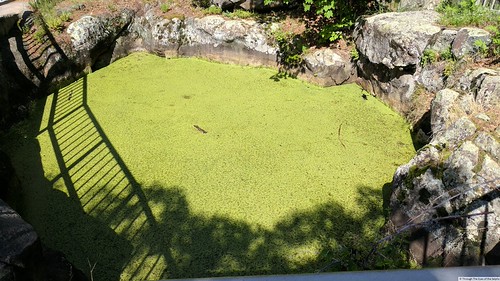We left Baudette under sunny skies and warmer temperatures and headed south. Baudette was the northernmost campground location for our 2017 summer travels.
We talked about stopping in Bemidji to see the huge statue of Paul Bunyan and his Blue Ox. Remember, legend has it that Blue Ox stomping through Minnesota is what caused the 10,000+ lakes to form.  We decided it wasn’t worth taking the RV towing the car off our route into Bemidji just to see a couple statues. As luck would have it a bridge was out and we had to take a detour. The detour took us right past the Bunyan and Blue Ox statues so I snapped a picture out of the window of the RV as we drove past.
We decided it wasn’t worth taking the RV towing the car off our route into Bemidji just to see a couple statues. As luck would have it a bridge was out and we had to take a detour. The detour took us right past the Bunyan and Blue Ox statues so I snapped a picture out of the window of the RV as we drove past.  We also noticed a sign saying that Bemidji was the first city on the Mississippi.
We also noticed a sign saying that Bemidji was the first city on the Mississippi.  The Mississippi River is still narrow here approximately thirty miles from the Mississippi Headwaters.
The Mississippi River is still narrow here approximately thirty miles from the Mississippi Headwaters.
We arrived at Leech Lake Recreation Area – Corps of Engineers Park, located in the very small city of Federal Dam MN. Bill booked far enough ahead to get one of the few full hook up sites. Leech Lake is Minnesota’s third largest inland lake and is located in the Chippewa National Forest. One of three area Ojibwe Indian reservations is located at Leech Lake.


I was needing to do laundry and I was thrilled to find the campground had a laundry facility with what looked like new washers and dryers. The best part was the washers and dryers were free!
 While staying at Leech Lake we drove an hour to Itasca State Park near Park Rapids. The park was established in 1891, making it Minnesota’s first state park. It is the second oldest state park in the United States with only Niagara Falls State Park being older.
While staying at Leech Lake we drove an hour to Itasca State Park near Park Rapids. The park was established in 1891, making it Minnesota’s first state park. It is the second oldest state park in the United States with only Niagara Falls State Park being older.
The park contains 32,690 acres, 220 campsites, cabins for rent as well as lodging at the historic Douglas Lodge. Our main reason for visiting this park is because it is the headwaters of the Mississippi River. With its source being Lake Itasca, it is here the Mississippi River begins its 2,552 journey to the Gulf of Mexico. Minnesota has 694 miles of the Mississippi River, more than any other state. It drains water into the Mississippi River from half the state.

We first stopped at the beautiful Visitors Center with many exhibits on the animals and plants in the park as well as the history of the area. They had a nice display area honoring the Civilian Conservation Corps (CCC). The CCC program in Minnesota alone trained 84,000 men in job skills and conservation. They worked forty hours a week and were paid $30 a month of which $25 was sent home to help their families. The remaining $5 could be used by the men for personal items. They also received medical and dental care. The Visitors Center also had informative displays about the mighty Mississippi River.

We drove the Main Park Drive as well as the ten mile paved Wilderness Drive throughout the park stopping at several interesting exhibits.
At the headwaters of the Mississippi River is a 44 foot long outlet dam so tourists can wade across the river in shallow water. 



 There is also a bridge constructed of one big log.
There is also a bridge constructed of one big log.
Approximately 7-8,000 years ago Native Americans hunted in this region. They ambushed bison, deer and moose at the animals’ watering holes and killed them with stone tipped spears.  There is a bison kill site uncovered in 1937 during the construction of Wilderness Drive. Ancient bison bones dating back 8,000 years ago were unearthed as well as knives, spears and scrapers. A large skull is on display at the park Visitors Center.
There is a bison kill site uncovered in 1937 during the construction of Wilderness Drive. Ancient bison bones dating back 8,000 years ago were unearthed as well as knives, spears and scrapers. A large skull is on display at the park Visitors Center.  We stopped by the bison dump site but there is nothing to see there today. We could imagine bison grazing at the watering hole with Indians approaching.
We stopped by the bison dump site but there is nothing to see there today. We could imagine bison grazing at the watering hole with Indians approaching.
Five hundred to a thousand years ago Woodland Indians lived in this region. They made clay pots and hunted with bows and arrows. Their burial mounds are at the Itasca Indian Cemetery. There is nothing really to see here either. Just a pathway with fencing on each side of over grown grassy areas.
In 1832 explorer Henry Schoolcraft, with the help of an Ojibwe guide, found the source of the Mississippi River at Lake Itasca. He named the lake Itasca from the Latin words “truth” and “head”.
We stopped by a replica of the pioneer store and homestead site from the late nineteenth century, home of Theodore and Johanna Wegmann, early park pioneers.
There was also a Pioneer Cemetery with the graves of over a dozen early Itasca homesteaders.
In the late nineteenth century concerns over logging and the need to protect the pine forests for the enjoyment of future generations led to the establishment of the state park. The park includes the virgin red pine, Minnesota’s state tree. Some of the red pine in the park are over two hundred years old. This park is one of the few places in the state that has preserved these pines from destruction.
Retreating glaciers 10,000 years ago left 157 lakes in the 3,000 acre park of different sizes.
Overpopulation of white-tailed deer is a problem in the park with a deer density of 15 to 17 per square mile compared with 4-10 per square miles in other areas. Annual deer hunts have been held since 1940 in an attempt to curb the deer population.
In the winter the average temperature is -4 F with average snowfall amounts of 54.6 inches!
What a wonderful day in a beautiful park!
 On the way home we stopped in Akeley to see another Paul Bunyan statue. This one is over thirty feet tall! It was erected in 1984. Akeley advertises itself on its welcome sign as the birthplace of Paul Bunyan. Interesting since Paul Bunyan is a folklore hero. Seems at least ten towns from Maine to Wisconsin to Michigan to Minnesota claim the same thing. Apparently blatant attempts to increase tourism, but it got us to stop. And we did buy gas while we were there, so they got us! And you really can’t blame a small town with a population of 1,100 to use tricks to get tourist dollars. At least they didn’t charge us admission!
On the way home we stopped in Akeley to see another Paul Bunyan statue. This one is over thirty feet tall! It was erected in 1984. Akeley advertises itself on its welcome sign as the birthplace of Paul Bunyan. Interesting since Paul Bunyan is a folklore hero. Seems at least ten towns from Maine to Wisconsin to Michigan to Minnesota claim the same thing. Apparently blatant attempts to increase tourism, but it got us to stop. And we did buy gas while we were there, so they got us! And you really can’t blame a small town with a population of 1,100 to use tricks to get tourist dollars. At least they didn’t charge us admission!
Our last day in Leech Lake, with the arrival of July 1st, Minnesota, the land of 10,000 lakes turned into the state from hell. Mosquitoes arrived with a vengeance. Our last night in Leech Lake Bill killed over thirty mosquitoes INSIDE the RV! We hope as we head south away from the lakes the number of mosquitoes will decrease.
Next stop: Aitkin, MN as we continue south
Mississippi River Facts:
- The Mississippi is the fourth longest river in the world. Many small rivers and streams flow into the Mississippi with the Missouri and Ohio Rivers being the largest. Together all these connected rivers and streams make up the largest river system in North America with a combined waterway length of more than 15,000 miles. The Mississippi River drains water from 31 states and two Canadian provinces. It begins as a small stream at Itasca State Park and is over two miles wide by the time it reaches the Gulf of Mexico.

- A raindrop that falls in Lake Itasca will arrive at the Gulf of Mexico in about 90 days.

- The length of the Mississippi has been shortened over time by over 200 miles due to channelization.
- The river is 1,475 feet above sea level at Itasca State Park and at sea level when it enter the Gulf of Mexico. Over half the elevation drop occurs in the first third of the journey before it leaves Minnesota.
- The average surface speed of the river is 1.2 miles per hour.
- Although the air temperature in the winter may reach -40 F, the rocky headwaters where the water flows from the lake into the river rarely freezes over because springs feed enough water into the lake so the river flows all year.
- The volume of water leaving Lake Itasca is six cubic feet per second, about a bathtub full of water per second. The volume of water when it reaches the Gulf of Mexico is 468,000 cubic feet per second, about 80,000 times more than when it started.
- The Mississippi River watershed drains 41% of the continental United States, between 1.2 and 1.8 million square miles.
- The Mississippi River touches ten states.
























































































































































































































